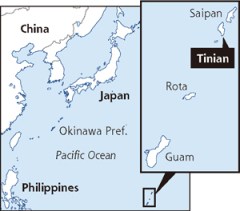B-29s from the 462nd Bomb Group prepare to take off from Tinian atoll’s West Field on a bombing raid over Japan in 1945.
TOKYO – It’s not clear if anyone appreciates the irony, but Japan wants to help pay for a new U.S. military base on Tinian island, a former Imperial Army stronghold from which the atomic bombings of Japan were launched in August 1945.
The base would become a joint training facility for U.S. Marines and Japan Ground Self-Defense Force troops. It’s part of the ongoing negotiations to relocate Marines from Okinawa and realign US forces throughout the Asia-Pacific region.
Japan raised the joint-base idea after the U.S. proposed raising Japan’s share of the relocation costs. Under a 2006 agreement, the cost of moving up to 8,000 Marines from Okinawa to Guam was capped at $2.8 billion. The U.S. now wants Japan to pay at least $4 billion, plus another $300 million for repairs to a Marine air base on Okinawa.
Putting a joint base on Tinian would save the long trip to Camp Pendleton, Calif., where the Japan’s Self-Defense Forces conduct periodic amphibious-warfare training with the Marines. It could also spare political problems for both the Americans and Japanese since Tinian is part of the U.S.-administered Northern Mariana Islands.

Yomiuri Shimbun
“If Japan is going to spend money on US bases anyway, then this is a good opportunity to develop a real co-partnership,” says Prof. Takashi Kawakami, a military affairs specialist at Tokyo’s Takushoku University. “There is not much space for training in Japan, so it benefits both the JGSDF and the Americans.”
About 200 Marines based in Iwakuni, Japan, are scheduled to begin a month-long training exercise on Tinian next month – the first there in more than a decade — but no plans for building a permanent base have been disclosed. The plan was first reported by the Yomiuri Shimbun. About two-thirds of Tinian atoll is leased by the Pentagon.
Marines seized Tinian and nearby Saipan in June 1944 in some of the most vicious fighting of the war. Some 3,000 American and 30,000 Japanese troops were killed; 22,000 civilians died, including 1,000 who threw themselves off Saipan’s steep cliffs rather than surrender to the Americans.
The defeat sealed Japan’s fate. Within weeks, Tinian was turned into a sprawling base for B-29 raids on Japan. The atomic bombings of Hiroshima and Nagasaki, both launched from Tinian airfields, brought an end to the war.
Kawakami says few Japanese are aware of the role that Tinian played in Japan’s defeat.
“Most Japanese will think of this as a new base, so there is some irony in that, in fact, we would be going back to one of our old bases,” he says.


